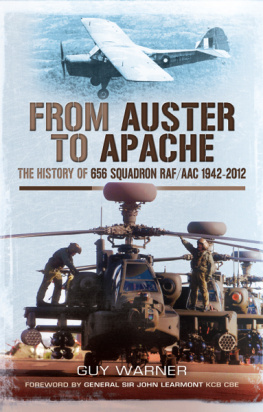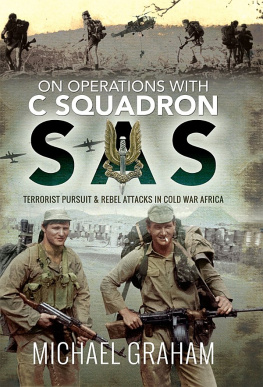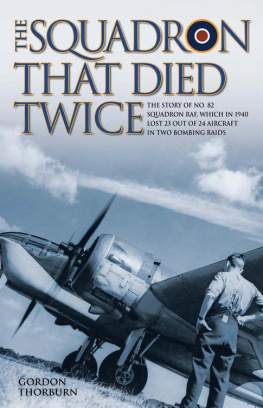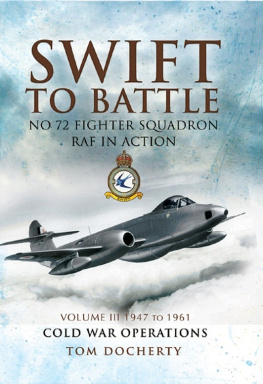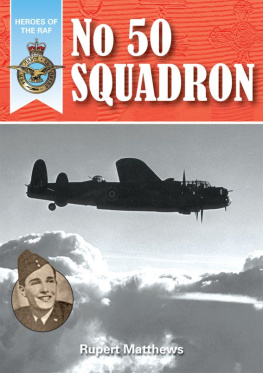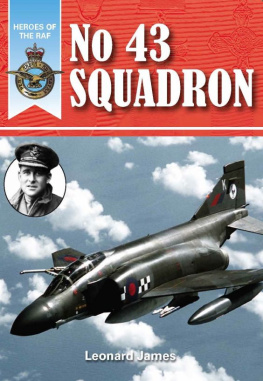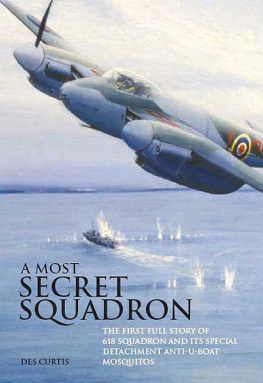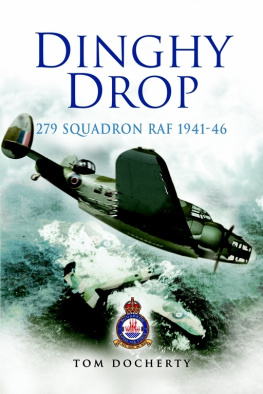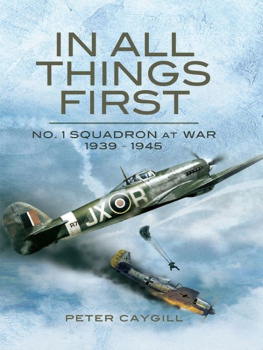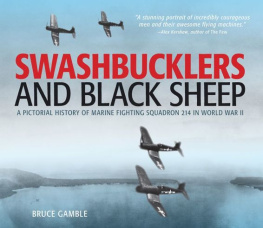First published in Great Britain in 2013 by
Pen & Sword Aviation
an imprint of
Pen & Sword Books Ltd
47 Church Street
Barnsley
South Yorkshire
S70 2AS
Copyright Guy Warner 2013
ISBN: 978-1-78159-098-0
EPUB ISBN: 978-1-47382-246-7
PRC ISBN: 978-1-47382-198-9
The right of Guy Warner to be identified as author of this work has
been asserted by him in accordance with the Copyright, Designs and
Patents Act 1988.
A CIP catalogue record for this book is available from the British Library.
All rights reserved. No part of this book may be reproduced or transmitted in
any form or by any means, electronic or mechanical including photocopying,
recording or by any information storage and retrieval system, without
permission from the Publisher in writing.
Typeset in 11pt Ehrhardt by
Mac Style, Beverley, E. Yorkshire
Printed and bound in India by Replika Press Pvt. Ltd.
Pen & Sword Books Ltd incorporates the Imprints of Pen & Sword Aviation,
Pen & Sword Family History, Pen & Sword Maritime, Pen & Sword Military,
Pen & Sword Discovery, Wharncliffe Local History, Wharncliffe True Crime,
Wharncliffe Transport, Pen & Sword Select, Pen & Sword Military Classics,
Leo Cooper, The Praetorian Press, Remember When, Seaforth Publishing
and Frontline Publishing.
For a complete list of Pen & Sword titles please contact
PEN & SWORD BOOKS LIMITED
47 Church Street, Barnsley, South Yorkshire, S70 2AS, England
E-mail:
Website: www.pen-and-sword.co.uk
Contents
Foreword
By
General Sir John Learmont KCB, CBE
I t is always a privilege to be invited to write a Foreword and it gives me great pleasure to do so for Guy Warners timely book on 656 Squadron. It is timely in the sense that although the Squadron is far from being the oldest Army aviation squadron, it is unique in having a near continuous operational record and it reaches the milestone of celebrating its 70th anniversary in early 2013.
The Air Observation Post (Air OP) concept was contentious when advocated by its pioneer, Captain Charles Bazeley RA in 1938 and was fiercely resisted by the Air Ministry. The idea of Royal Artillery officers flying rudimentary, unarmed aircraft to control artillery fire was inspired, but took until 1941 to be realized with the first Air OP Squadron, No 651. Yet the practice worked even better than the concept and by the time 656 Squadron formed up at RAF Westley in early 1943, the squadron establishment and concept of operations had been tested, by 651 Squadron, in North Africa. However, 656 Squadrons first Officer Commanding, Major Denis Coyle DFC, MBE, RA, with whom, in later life, I was privileged to serve in the 1950s, was made aware that his command would not be deployed close to home, but in the more distant and uncertain environment of the Burma Campaign, in support of 14th Army. On arrival in the Far East, he was immediately faced with two major problems. Firstly there was a complete lack of comprehension on how to deal with an RAF/RA aviation unit, by both the Army and RAF administrations, which led him to make farsighted, unilateral decisions. Secondly, whereas in other theatres, Air OP squadrons were able to deploy a flight in support of a division, Denis Coyles only option was to place his flights at the disposal of a corps, while sections of a single Auster and pilot and his four man joint RAF/RA support team were regularly detached to support divisions. Such was the effectiveness and popularity of these self-sufficient sections that they became a modus operandi, and led to a close trust and loyalty between pilots and divisional commanders.
Acts of great heroics and airmanship were conducted in the harshest of conditions. Two pilots were to receive both the MC and DFC which remains unsurpassed while nine DFCs were awarded in total. Towards the end of World War II the Squadron deployed to Malaya, where it was to remain for the next twenty-five years, providing intimate aviation support throughout the Malaya Emergency and Indonesian Confrontation. During this period the Squadron successfully dispatched sub-units/support to Java, Hong Kong, Korea, Brunei and Borneo.
In 1957 the Squadron transferred to the newly formed Army Air Corps (AAC), when it was retitled 656 Light Aircraft Squadron AAC. Gradually, light blue beret REME replaced RAF technicians, and airtroopers took over ground crew duties. While there were major changes of personnel, the ethos and spirit engendered by Major Coyle was retained. By the early 1960s the Squadron was equipped with the wholly unreliable Scout helicopter providing a challenge for pilots and technicians alike while it also retained a fixed wing capability with the robust Beaver aircraft. In preparing to leave Malaysia, the Squadron Report stated:
So 656 Squadron flies out of Malaysias history. We are sad to be closing down, for after all, this is the Aviation unit with the longest record of active service; twenty-three out of twenty-seven years have been spent on opera tions, from the Arakan to Imphal and on to Rangoon, from Java and Sumatra to the Thai Border and all over East Malaysia flying a total of over 250,000 hours on operations. All of us who served with 656 in any capacity are proud to have done so.
The Squadrons total flying hours in an operational theatre is a record not matched by any RN, AAC or RAF squadron to this day. From Malaysia the Squadron moved to Hong Kong, where, for the next eight years, it was well prepared to support operations to identify and capture illegal immigrants.
In 1978, 664 Squadron based in Farnborough was retitled 656 Squadron as part of a larger AAC reorganization. Shortly afterwards it was deployed on Op AGILA to support the Commonwealth Monitoring Group in Rhodesia/Zimbabwe, in the build-up to free elections. I was the Deputy Commander, so came into contact with many of the Squadron personnel on a daily basis, and was a regular passenger in their Scout and Gazelle helicopters. The Squadrons contribution to the Operation was immense and I believe that without the skill and professional expertise of the pilots, and the positive leadership shown by those in command, the Operation would not have succeeded. This was my first experience of working closely with Army Aviation, prior to being appointed Colonel Commandant of the Army Air Corps in 1988, a position which I was honoured to hold for the next six years.
In early 1982, the Squadron was tasked as the only AAC squadron to deploy on Op CORPORATE to recover the Falkland Islands from the Argentinian Forces. This operation provided no precedents, where innovation and courage were essential to success. The Scout and Gazelle flights operated in the harshest of conditions, providing close support often under fire to the advancing forces. Their determination to recover casualties, regardless of the time of day or night or weather conditions, is a testament to their sense of duty. Two pilots were awarded the DFC.
During the 1990s, the Squadron continued to be deployed on operations, particularly in Bosnia-Herzegovina and Croatia in support of the Cessation of Hostilities Agreement.
In 2003 the Squadron was selected to be the first AAC squadron to convert to the Apache. the deployment of the Attack Helicopter was to be a severe test and a major step-change which was critically observed by the RAF. Captain Piers Lewis, later to become OC in 2012, found that the conversion was: a real change in gear, going from 2nd in a Gazelle to 5th in the Apache.
The Squadron has subsequently deployed on three operational tours of Afghanistan, and in 2011 operated five Apaches from HMS Ocean off the coast of Libya during Op Ellamy. The Apache chapter reads like an adrenalin rush of acronyms and with a pace of support and kinetic operations which lends itself to a generation which readily embraces modern digital technology and personal challenges. Two MCs were awarded to aircrew which points back to similar awards in 1945.
Next page
